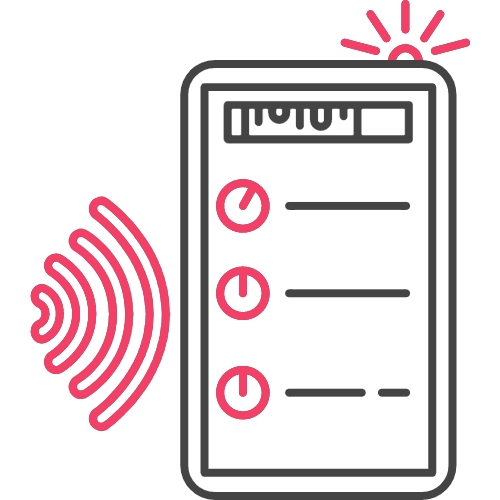Keep up with the latest IoT-based building automation, and follow us on LinkedIn!
The Internet of Things has enabled us to connect various devices and systems, creating a seamless network that can be accessed and controlled remotely. In the field of building automation systems, IoT has played a significant role in improving efficiency, reducing costs, and enhancing building operations. This article will explore the benefits of IoT in building automation and how it’s transforming the industry.
What is Building Automation System (BAS)?

A Building Automation System (BAS) is a system that controls and monitors various building systems, such as heating, ventilation, air conditioning, lighting, security, etc. A building automation system aims to optimize the performance of these building systems, reduce energy consumption, and enhance occupant comfort.
A building automation system comprises various components, including sensors, controllers, and actuators. Sensors detect changes in temperature, humidity, occupancy levels, and other variables. Actuators, such as valves and dampers, control the settings of the building systems according to control schedules and other inputs.
BAS can be programmed to respond to a range of variables, such as occupancy levels, time of day, and weather conditions. For example, a BAS can adjust the lighting and HVAC settings based on occupancy levels and time of day, reducing energy consumption when the building is unoccupied.
BAS is a wired system managed and monitored through a central control room within the building, allowing building managers to adjust settings and respond to alerts.
Integration of IoT with building automation system
Integrating IoT (Internet of Things) with building automation systems (BAS) allows for a more seamless and efficient management of building systems. IoT technology enables the integration of various devices and systems of the building, creating a unified network that can be monitored and controlled remotely.
The integration allows for optimized energy consumption and improved occupant comfort. By creating a unified network of devices and systems, building managers can optimize the performance of their buildings and respond quickly to any issues that may arise, even remotely.
Key components in IoT-powered Building Automation System
1. IoT Sensors

IoT sensors collect data such as temperature, humidity, CO2, and air quality. These sensors are used in building automation systems to monitor various aspects of a building’s ambient environment.
2. Smart Devices/Actuators

Smart devices can be controlled remotely and act according to other devices (sensors) in a network. In building automation systems, smart devices are used to control equipment such as lighting, HVAC, refrigeration etc. For example, a smart thermostat can adjust temperature settings based on occupancy levels, time of day, and weather conditions identified by the IoT sensors.
3. Cloud Computing

Cloud computing enables building automation systems to store and analyze large amounts of critical data. This data can be used to optimize energy usage, detect potential problems, and improve overall efficiency. Cloud computing also enables remote access to building automation systems, allowing managers to monitor and adjust settings from anywhere in the world.
4. Artificial Intelligence & Data Analytics

Artificial Intelligence (AI) is used in building automation systems to analyze data and make decisions based on that data. AI algorithms can detect patterns in data and make predictions about future trends. For instance, an AI algorithm can analyze energy usage data, vibration patterns, etc., and predict when equipment is likely to fail, enabling facility managers to schedule maintenance before the equipment breaks down completely.
Applications of IoT in Building Automation System
IoT enables the integration of various systems and devices, creating a seamless network that can be monitored and controlled remotely. Let’s look at a few applications:
1. Smart Energy Management
IoT-based energy meters are used to monitor the actual power consumption and other energy parameters of all the critical assets & equipment of the building. This energy usage data is then processed and presented as insights & recommendations for better energy optimization.
Moreover, such solutions also allow for energy benchmarking for evaluating and assessing the energy consumption of various building assets, equipment & machinery. Energy benchmarking makes it easy to identify inefficient equipment, make decisions about potential improvements, and make informed long-term energy management decisions. With a better understanding of possible improvements, one can integrate best energy management practices into day-to-day operations and achieve higher energy efficiency by eliminating potential energy waste.
Similarly, sensors can detect temperature, humidity, and occupancy levels, enabling the HVAC system to work optimally to maximize occupant comfort and energy efficiency. For example, the system can adjust the HVAC settings based on the current ambient environment, occupancy levels, and time of day, optimizing energy usage.
2. HVAC Automation & Control
IoT sensors and smart devices can be used to optimize HVAC settings, improving occupant comfort and reducing energy consumption. Sensors can detect air quality, CO2, temperature, and humidity levels, enabling the system to adjust the HVAC settings accordingly. Smart devices like smart thermostats can control the HVAC system remotely.
3. Smart Lighting Control
Lighting settings can be optimized using IoT-powered building automation systems, improving energy efficiency and occupant comfort. Sensors can detect occupancy and adjust lighting levels as needed. Furthermore, manual operations can now be performed automatically through smart scheduling of lighting systems based on operating hours, reducing energy waste caused by equipment running outside operating hours.
4. Predictive Maintenance
IoT-powered building automation systems can be used to detect potential problems in building equipment and systems, enabling building managers to schedule maintenance before the equipment breaks down completely. For example, sensors can detect changes in vibration or temperature, indicating that a piece of equipment may malfunction. This enables building managers to schedule maintenance before the equipment fails, reducing downtime and repair costs.
5. Remote Monitoring and Control
IoT-powered building automation systems enable remote monitoring and control of building systems, allowing building managers to monitor and adjust settings from anywhere in the world. This is particularly useful for multi-site buildings or for building managers who need to travel frequently. Remote access also enables faster response times to emergencies and reduces the need for on-site maintenance.
IoT-powered automation is transforming the building automation industry by improving efficiency, reducing costs, and enhancing occupant comfort. The benefits of IoT in building automation include improved energy efficiency, enhanced building security, remote access and control, and cost reduction.
Key IoT technologies used in building automation include sensors, smart devices, cloud computing, artificial intelligence, and advanced data analytics.
With the continued growth of IoT, the building automation industry is poised for even greater transformation in the years to come.
Get in touch with our IoT specialists to know how IoT-powered building automation can help your business’s bottom line.
Keep up with the latest IoT-based building automation, and follow us on LinkedIn!
